
WVXU: Monarchs land on international endangered list
UC biologist Patrick Guerra explains how we can help monarchs survive epic migration
WVXU's Cincinnati Edition turned to a University of Cincinnati biologist to explain why monarch butterflies are in decline and what we can do to help.
The International Union for the Conservation of Nature last month placed monarch butterflies on its "red list" of endangered species, a warning that the species is in decline and at risk of extinction.
UC College of Arts and Sciences assistant professor Patrick Guerra told WVXU that the question of whether the species is in danger of extinction is complicated by the fact that they engage in a multi-generational migration. That makes a census somewhat trickier, he said.
"It really is a question of when you are looking at the population because there are different generations making this journey and what's the metric you use?" he said.

UC biologist Patrick Guerra works with monarch butterflies. Photo/Lisa Ventre/UC
Guerra was joined in the interview with Lily Maynard, the director of global conservation at the Cincinnati Zoo & Botanical Garden.
Guerra said monarchs are important pollinators for various species of flowering plant. But more than that, we can learn a lot from their incredible navigational abilities, he said.
A study this year by Guerra found that nighttime light pollution can interfere with their uncanny navigational abilities. Guerra found that butterflies roosting at night near artificial illumination such as a porch light can become disoriented the next day because the light interferes with their circadian rhythms. Artificial light can impede the molecular processes responsible for the butterfly’s remarkable navigational ability and trigger the butterfly to take wing when it should be resting.
The U.S. Fish and Wildlife Service in 2020 said the monarch butterfly warranted protection under the federal Endangered Species Act, but was precluded because of other species that had higher protection priorities.
"The IUCN red listing is a call to action," Guerra told Cincinnati Edition host Lucy May. "I think they will be placed on the Endangered Species List."
Guerra said people who want to help monarchs can plant milkweed around their homes and gardens and turn off outdoor lights where possible.

UC assistant professor Patrick Guerra and his students work with monarch butterflies at the Cincinnati Zoo & Botanical Garden. Photo/Lisa Ventre/UC
Related Stories
UC's art collection on display at the Contemporary Arts Center
January 5, 2026
University of Cincinnati leaders joined WVXU's Cincinnati Edition to talk about the university’s 200-year-old art collection, a new exhibition at the Contemporary Arts Center and the release of a companion book exploring the collection’s role in education and public engagement.
UC faculty and staff among Rising Star leadership honorees
January 5, 2026
Two UC faculty and staff members are among this year's Rising Star leadership program sponsored by YWCA Greater Cincinnati. Kelli Beecher, assistant professor in the UC College of Nursing, and Brittany Bibb, assistant director of programs and operations in the UC Division of Student Affairs, are among the emerging leaders of 2026. They were featured in the publication Movers & Makers.
What's behind the mysterious rise of migraines?
January 5, 2026
Weather patterns such as extreme heat and storm conditions have been linked to migraine attacks, and research shows those environmental conditions are becoming more common. As National Geographic recently reported, one of the leading theories behind this mysterious rise is that climate change may be playing a role.
